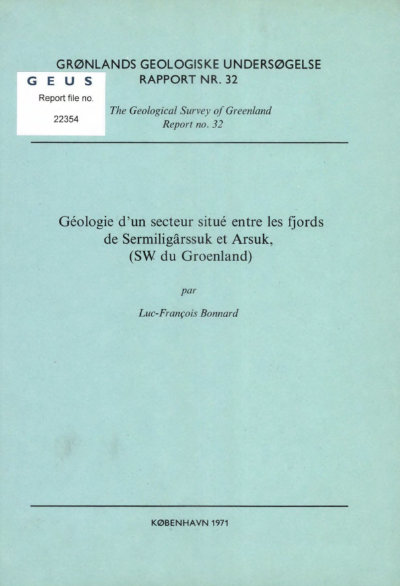Géologie d'un secteur situé entre les fjords de Sermiligârssuk et Arsuk, (SW du Groenland)
DOI:
https://doi.org/10.34194/rapggu.v32.7246Abstract
South-west Greenland belongs to the Precambrian shield; it is buiIt up of metamorphic, eruptive and, to a lesser extent, sedimentary rocks. The chronology of these formations and their structural relations are now fairly well established and are referred to three periods - pre-Ketilidian, Ketilidian and Gardar. Important unconformities separate the rocks of these divisions at the type localities. The greater part of the rocks occurring in the region mapped by the author belong to the pre-Ketilidian; these are migmatites - quantitatively the most important, ultramafic rocks, and metadolerites in various stages of alteration. The Ketilidian period was marked by local tectonic movements, metamorphism and the intrusion of small granitic bodies; the Ketilidian supracrustal succession lies immediately to the east of the area under consideration. The Gardar period has left its imprint in the form of widespread fractures and a dyke swarm composed mainly of dolerites and trachytes. The migmatites are predominantly gneisses, homogeneous and nebulitic in the north, banded and veined in the south. AlI the gneisses have a granodioritic or quartz-dioritic composition. Small masses of granite and sorne lenses of gabbro-anorthosite make up the remainder of the migmatite area, which structurally consists of a succession of domes and synclines with axes oriented in a general NW-SE direction with a culmination in the region of Dubletsø. The migmatite complex was probably derived from pelitic and arkosic sediments; it is the product of the metamorphism, migmatisation and intense deformation which marked the pre-Ketilidian. The ultrabasic bodies appear as small bodies within the migmatites: they are classified as steatites, serpentinites and actinolitites, the mutual relations of which form the subject of various hypotheses; it is probable that there exist two generations of ultrabasics separated by a phase of folding and migmatisation. The pre-Ketilidian metadolerites (like the later Gardar dykes) trend for the most part NE-SW. In the southern part of the area they are almost totally recrystallised due to later (presumably Ketilidian) metamorphism. The Ketilidian activity in the area was characterised by a metamorphism of variable intensity, most marked in the south-east of the area where it accompanied tectonic deformation. Dykes of microgranite and sorne small granitic and microdioritic bodies also belong to this period. The Gardar dyke complex comprises rare lamprophyres, trachytes and above all very numerous dolerites of which it is possible to distinguish several generations on the basis of intersections and microscopic characters. The fracturing and wrench-faulting described are also of Gardar age. FinalIy, within·the area many features of Quaternary and recent origin may be seen; these are the result of glaciation and the present arctic conditions.
Downloads
Published
Issue
Section
License
This article is distributed under a CC-BY 4.0 licence, permitting free redistribution and reproduction for any purpose, even commercial, provided proper citation of the original work. Author(s) retain copyright over the article contents.


